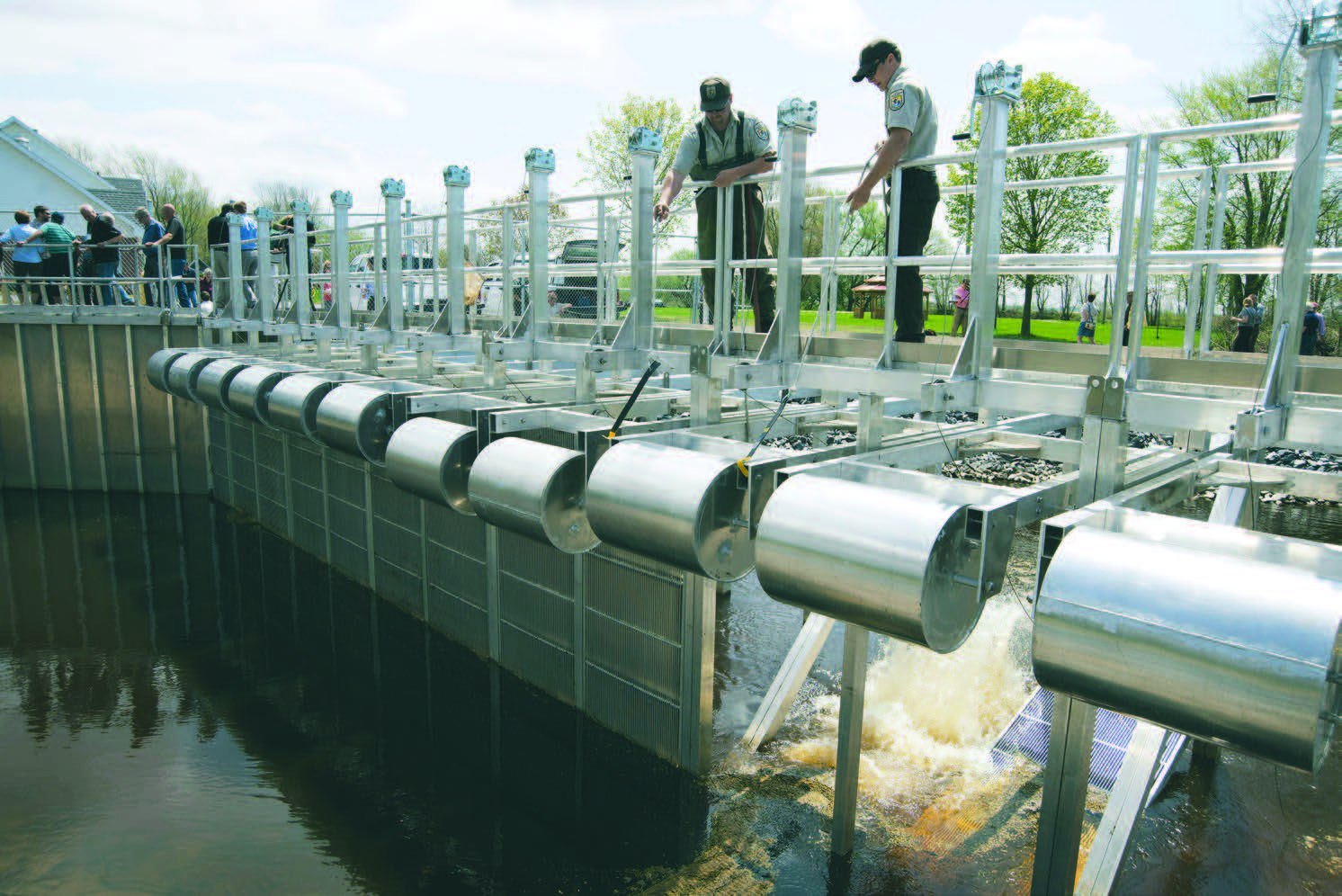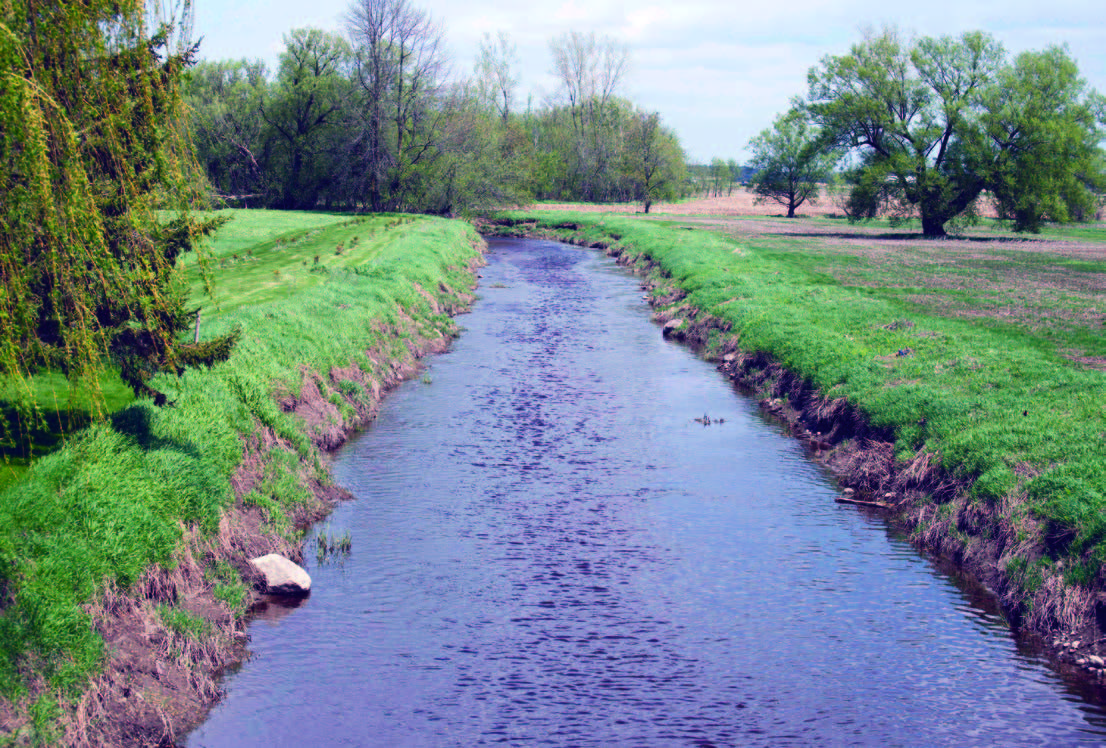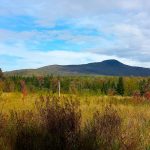Fish and Wildlife Service representative holds up a lamprey eel that was trapped in the new lamprey barrier in Notre-Game-de-Stanbridge on Morpion Creek, a tributary of the Pike River. The barrier traps the destructive, non-native eels but allows other fish to pass upstream. (photo : Robert J. Galbraith)
NDLR : Robert, un résident de Philipsburg, est photojournaliste professionnel et un inconditionnel protecteur du Lac Champlain. Vous l’avez sans doute croisé si vous fréquentez le lac ou ses berges. Il nous sert ici un magistral coup de gueule qu’il vaut la peine de lire attentivement, parce que l’homme sait de quoi il parle.
Last summer, episodes of the block-buster weekly television series, ‘River Monsters’ aired around the world on public television. One particularly squeamish episode entitled ‘Vampires of the Deep’ documented attacks on humans by sea lamprey eels in Lake Champlain. These disgusting, non-native, 2-foot-long, blood-sucking eels, invaded our waterways accidentally from Europe over 50 years ago, when ships returning from Europe emptied their ballast water into the St Lawrence River and the Great Lakes.
But it wasn’t only water they were releasing from their ballasts ; that same water contained lamprey eels, a non-native, invasive species which spread unabated to literally every large body of water in North America, including Lake Champlain and the Richelieu River. These parasites would eventually end up devastating the commercial freshwater fishing and sport fishing industry in the Great Lakes and other large bodies of water on the continent, at a cost of hundreds-of-millions of- dollars and still counting. Many of us old enough to remember, first heard about the existence of lamprey eels during 16-year-old Marilyn Bell’s swim across Lake Ontario in September 1954, when the Canadian swimming hero had to pause to have lamprey eels (which only come out to prey on fish at night) that had attached to her to suck her blood, pulled from her legs and arms. She eventually completed the swim after 21 hours, becoming the first person to complete this amazing feat.
Because of the devastation brought about by the presence of sea lampreys, U.S. Fish and Wildlife Service (USFWS) officials have been trying to control the parasite for over 40 years by applying a chemical lampricide treatment ; a type of chemical agent used in U.S. waterways to kill the young eels before they mature and reproduce.
Last month, as part of this eradication process, the USFWS inaugurated a lamprey eel barrier (the first of its kind east of the Great Lakes) in Notre-Dame-de- Stanbridge, on Morpion Creek, a tributary of the Pike River. The innovative barrier impedes the lampreys from swimming upstream to breed while letting other fish species pass unimpeded. There were well over 100 officials and local residents at the well-attended launch in Notre- Dame, which was a great success and showed that the local community is seriously concerned about their health and the environment.
The barrier project cost $1.5 million to plan and construct, with funding coming from the U.S. Great Lakes Fishery Commission, but without any funding from Quebec where the barrier is located. However, in the grand scheme of things, $1.5 million is mere pittance compared to the damage the eel (which is actually a species of fish and related to the eel family) causes to the fishing and tourism industry of the Lake Champlain region.
The barrier will address the last of the uncontrolled populations of sea lampreys in the Champlain Basin ; that of the Pike River. All other lamprey spawning grounds in the Basin’s streams and rivers are under treatment and eel numbers are slowly dropping. It is hoped that in 5-6 years, the lamprey problem on the Pike will be eradicated and Lake Champlain can recover from the devastation caused by the blood-lusting vampires.

With an overall economic impact of $200 million dollars for the lake region, officials estimate that lamprey eels’ destructive ways take a $20-$40 million chunk out of that economy each year. After all, who wants to go on vacation and catch a trout or salmon with an eel stuck onto its belly, sucking the fish to death ; or seeing the shotgun-like-blastwound left behind on a trout from a lamprey hit ? So the eel is a huge, huge factor in not only the environmental status of the lake but the economics of the region.
We must applaud the work of our American neighbors who had the foresight to conceive this barrier without any help from our embarrassing Quebec Ministry of Parks and Wildlife and Natural Resources, (or whatever this useless ministry calls itself now). It was the USFWS that deserves all the applause, along with the Lake Champlain Basin Committee, the Municipality of Notre- Dame and its very visionary mayor and council for agreeing to let the barrier be constructed in their village. There are others to be thanked like Senator Leahy and the Great Lakes Fishery Commission and I apologize if I have omitted others.
The Americans had been waiting for decades to have Quebec pull its weight on this international problem while the Lake Champlain economy south of Quebec took a freefall. And I’ll tell you, they were not happy about it !
I remember driving over the Pike River Bridge about 12 years ago when I saw a handful of University of Vermont biologists using electronic wands to shock lamprey larvae along the rivers’ shoreline as part of their study. When I introduced myself as a journalist, they asked me not to quote them and to photograph them from behind as they were not supposed to be in Quebec waters conducting a survey without provincial authorization. But they said that they were so fed up with those in Quebec who neglected the lamprey issue that they now don’t even inform them of their research except when absolutely necessary. So they were “going it on their own as Quebec offered no help whatsoever.”
The American researchers explained that every time they try to get a mutual agreement on anything dealing with the environment in the Lake Champlain region, they are dragged down and delayed beyond acceptance by the “political squabbling between Quebec and the federal government who can’t seem to get along even for a moment.” So rather than deal with the politically immature quicksand of Quebec and Canada, they work without them. Hence the lamprey barrier in Notre-Dame-de- Stanbridge was conducted without any Quebec ministerial input ; (they stayed in the background). Our local MNA, Mr. Pierre Paradis (the Quebec agricultural minister) was nowhere to be seen (at least by me), at the launch of this international gathering.
Most of those who work in the agricultural industry are good people, but it only takes a few slobs, with a “fuck you” attitude, to spoil it and taint that greater majority of concerned farmers ; those who are trying their very best to protect their children’s future and the environment, as well as trying to make a living and feed the world. It is the politicians who have set farmer against concerned residents, in the honourless battle for their vote.
The province may tell you they were involved (as part of a politically correct façade) – but that’s not the reality of this situation. In fact, this whole topic is an issue of embarrassment for the province and they preferred to sweep it under some rug (as they do with most environmental issues) and hope it never raised its head again. But it has, and now you know the ugly background details which the province didn’t want you to know about.
The province will say they didn’t want to use chemical lampricides because of their concern for the environment, but that was just an excuse for not doing anything at all. In Quebec, it is acceptable to legally plow your land right to the very edge of a body of water then stand back and watch the unimpeded flow of pesticides, herbicides, soil, fungicides, pig slurry, cow waste, phosphates, nitrates, raw sewage flow from the land and into our rivers and lakes ; but the province wouldn’t even consider using a lampricide, regardless of the hundreds of studies which show the positive effects far out ways the negative effects of using a lampricide ? Ignorance is bliss isn’t it ?
The environmental cost of eradication these parasites upstream with a lampricide is peanuts compared to what occurs in the main lake. If Quebec would have done their homework (and their job) they would have understood why the Americans needed our help. We had abandoned our neighbours again.
It is not unusual to catch 10 trout or salmon, in the deeper part of the lake with 9 of the fish having a lamprey clinging to it or a hit mark from an eel. The ministry hid behind the shroud of not using a chemical as their reason for not acting on the situation and they ended up looking once again – like idiots, in environmental circles across North America !

Considering the above ; isn’t it somewhat humorous that in a province which up until just a couple of months ago was striving for independence from one country (Canada), then to allow another country to softly breach its sovereignty and install this barrier, wouldn’t one think there would be an inkling of pride from Quebec in participating ? Hell no ! Damn the torpedoes ! Storm the Bastille ! ! !
For the last 40-odd-years, Quebec has been trashed and gutted by the independence movement ; not only economically but environmentally. The problems we see today with the blue-green algae and the lampreys or the huge poaching situation now present on Missisquoi Bay, are largely a result of the province turning its back on our right to a clean environment because the visionless leaders felt it is better to be independent, even if our children have to drink poisoned water or have their lakes turn into parasite infested sewers.
Well now there is a new ruling party at the helm in La Belle Province. Will things change as a result of this Liberal sweep – I really doubt it ? They are just as bad environmentally, or even worse than the Parti Quebecois ever were. Both parties have turned Quebec, on a world stage, into a banana republic when it comes to environmental concerns. The feds aren’t much better either when it comes to environmental health and welfare.
Now it’s time to push back ! Are you ready to stand up for our democratic right to clean drinking water and a healthy future for our children ? Well – sorry, but it’s just not going to happen because our rulers cater to the polluters. It’s only going to get worse.
Nothing has changed on Missisquoi Bay. Well actually, that’s a little lie, things have changed – but for the worst. The algae problem has been the worse ever over the past few years and shows no sign of improvement. Third-world agricultural practices and a lack of policing of farming methods are largely responsible for this predicament and any regulations lack enforcement because of the political cost of taking on the UPA (agricultural lobby). Remember, this is the same lobby group who a former president of blamed the migrating Canada Geese and other waterfowl for the algae problem in our lake. “Earth to the UPA ! ! ! Come in please ! ! !” This syndicate is the real power in our region and they run the show. When they shove – we fall down. Politicians are powerless to them. In fact, our elected officials might be considered slaves to the UPA.
If you run as a candidate and go up against them, their massive lobbying power will vote you out and someone who plays their game will be voted in. So there is a ton of money to be made from polluting and the blue green algae problem is a result of this – one sector of society drinks tainted water while the other profits from it – such a civilized society !
Professional poachers (like a Quebec version of Somali pirates) have taken over Missisquoi Bay because there is literally a skeleton crew of fish and game officers on patrol over the entire province and every poacher knows about it. But you don’t see poachers on Memphremagog or Brome Lakes because former prime ministers and billionaires live there and they wouldn’t put up with it. If you don’t believe me, try launching your boat on Magog. Before you even get it in the water, the fish cops are checking you out for aquatic plants stuck under the hull or for licenses. I might see the fish cops on our bay a couple of times of year at best. There is no law on Missisquoi Bay, it’s the wild, wild, West of fish poaching locations in Quebec.
Our society is broken by greed – and so is the environment and those who make decisions on preserving it. It’s like two different worlds – that of the haves who profit from pollution – and that of the have not’s – that is the rest of us. It’s time to step out of our caves and become civilized again. Future generations of our children are counting on us.
It is also time that our elected officials realize that some of the people who voted for them, voted to have their rights protected, and not for someone who is a tool of a big industry. So if you are looking for any sanity in this discussion, don’t hold your breath because the simple law of physics dictates that the politician caters to the majority who voted for him or her and since we live in an agricultural region – you can only expect things to get worse. If it hasn’t improved in over 30 years but only gotten worse, why the hell would you expect it to improve with this recent changing of the guard ? Who said life was fair ?

Autres articles
Avez-vous lu?
- La lumière au bout du tunnel
- Enfin un centre de pédiatrie sociale dans Brome-Missisquoi !
- Quatre projets pour cinq écostagiaires à Frelighsburg
- Maryse Messier, la Mary Poppins de Brome-Missisquoi
- Projet virage rivages
- Contacts avec les cyanobactéries
- Mot du président
- Des nouvelles de votre journal
- Emplois dans la communauté
- La petite histoire du journal ‘Le Saint-Armand’
















Laisser un commentaire
Nous n’acceptons pas les commentaires anonymes et vous devez fournir une adresse de courriel valide pour publier un commentaire. Afin d’assumer notre responsabilité en tant qu’éditeurs, tous les commentaires sont modérés avant publication afin de nous assurer du respect de la nétiquette et ne pas laisser libre cours aux trolls. Cela pourrait donc prendre un certain temps avant que votre commentaire soit publié sur le site.